|
Flower Essences More Effective for Stress
than Pharmaceutical Drugs
According to Cuban Military Study
Editor's note:
This article has been edited and adapted for English-speaking readers based on the original Spanish-language publication in the
Cuban Journal of Military Medicine
, which is found
here
.
Flower Essence Therapy has been part of the Cuban national health programs since 1999. This study was published in 2006 and is significant today because it shows how a population subjected to high-stress conditions can benefit from Flower Essence Therapy, even within a highly centralized organization such as the military.

Members of the Cuban military
Key Findings of the Study
The group of patients who received flower essences made greater progress and had a better clinical outcome than did the group that received pharmaceutical drugs.

|
Central Military Hospital
Havana, Cuba
|
The study included 50 patients from the Cuban military who tested for symptoms of stress. 25 were given flower essences (Group A) and 25 were treated with pharmaceuticals (Group B). The patients were tested for stress symptoms at the beginning of the study and at intervals until the end of the study, spanning a 60-day period. Four categories were established for assessment:
normal, mild, moderate and severe.
The following graphs, based on Table 3 of the study (shown later in the article), compare the clinical progress of the two groups. A significant finding is that the group receiving flower essences made more progress even though it started with more patients in the
severe
category.
|
At the end of the 60 day study most of the subjects in the flower essence group (A) were assessed as “normal,” with a smaller number having mild symptoms. Those subjects who received pharmaceutical medications (B) had equal numbers in the "normal" and "mild" categories, plus some still assessed as "moderate." This means that those who received flower essence therapy made greater progress than did those who received pharmaceutical medications.
|

|

|
Major Symptoms of Stress and Principal Flower Essences used
The study found that most prevalent among the stress symptoms were:
insomnia, poor memory (hypomnesia), obsessive behavior, depression, tension, sexual dysfunction, restlessness and irritability
The main flower essences administered in the study were: Garlic, Saint John's Wort, Sticky Monkeyflower, Hibiscus, Filaree, Yerba Santa, Chrysanthemum, Borage, Chaparral, Chamomile, Lavender and Rosemary.
|
A Review of the Therapeutic Benefits of the Major Flower Essences Used for the Cuban Military Study
by Patricia Kaminski
|
|
Garlic
Allium sativum
– Helpful for many states of obsessive behavior and underlying restlessness, due to parasitic influences that can be both psychic and physical; a powerful immune stimulant in such instances.
|
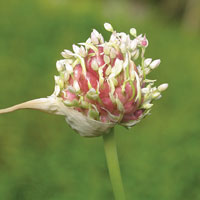
|
|
Saint John's Wort
Hypericum perforatum
– A baseline remedy for depression, building internal light structures that mediate between body and soul; helping the body-soul find equilibrium between psychological states of light and dark.
|
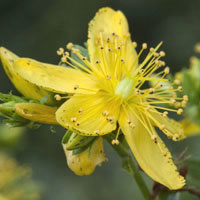
|
|
Sticky Monkeyflower
Diplacus aurantiacus (Mimulus aurantiacus)
– Addressing states of fear and anxiety related to sexual expression and identity; ability of the soul to experience positive sexual connections related to love and warmth.
|
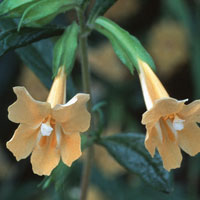
|
|
Hibiscus
Hibiscus moscheutos
– Nourishing sexual warmth and responsiveness, especially when prior trauma or cultural exploitation might have interfered with the soul’s positive connection to the body; restoring human dignity in the sexual identity.
|
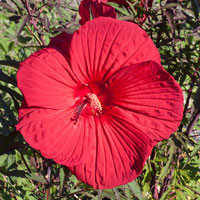
|
|
Filaree
Erodium cicutarium
– For many obsessive and compulsive behavior traits due to hyperfocus; the need for a wider, more comprehensive life perspective; relieves many forms of tension associated with hypervigilance and obsession with minor details.
|
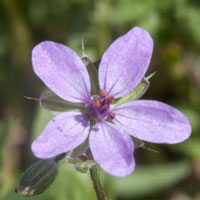
|
|
Yerba Santa
Eriodictyon californicum
– Greater emotional freedom due to the release of stored pain and grief, especially in the heart and lungs; alleviation of many symptoms of depression along with enhanced respiratory health.
|
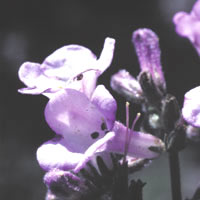
|
|
Chrysanthemum
Chrysanthemum morifolium
– Over-emphasis on the temporal personality, without a sense of the larger, more encompassing values and ideals of the soul; alleviation of many forms of restlessness and tension as the soul achieves a larger view of time and the soul’s purpose
|
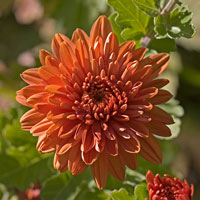
|
|
Borage
Borago officinalis
– Instilling greater buoyancy, adaptability, courage and confidence in the basic emotional outlook; works especially within the heart region; counters many forms of depression and tension.
|
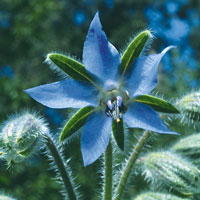
|
|
Chaparral
Larrea tridentata
– A powerful cleansing remedy often helping many states of insomnia and related sleep disturbances due to the buildup of psychic toxicity; unaddressed trauma due to drug use, violence or related psychic trauma.
|
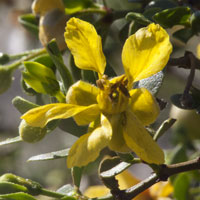
|
|
Chamomile
Matricaria chamomila
– A baseline remedy for many forms of emotional stress, such as irritability, agitation, and related restless behavior; helps build a more even disposition that remains stable and equanimous, despite daily fluctuations.
|
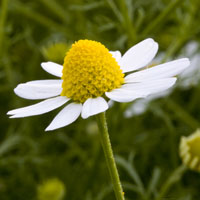
|
|
Lavender
Lavandula angustifolia
– A foundational remedy for many forms of nervous stress and insomnia, resulting in less mental tension and greater utilization of cognitive forces without nervous depletion.
|
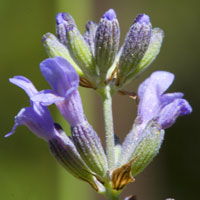
|
|
Rosemary
Rosmarinus officinalis
– A warming and vitalizing remedy that especially nourishes the forces of memory and mental coherency; warmth forces that allow for healthier incarnation of the soul in the physical body; especially indicated when prior trauma may have loosened this connection.
|
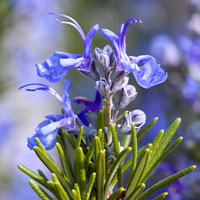
|
Details from the Original Study
Discussion of the Role of Stress in Health
The term “stress” was defined by the outstanding researcher
Hans Seyle
as an nonspecific biological response, characterized by changes in the central nervous, endocrine and immune systems, which he called the general syndrome of adaptation or biological stress syndrome.
1
Stress is associated with various elements of human life such as: cultural reactions, working conditions, accelerated rhythm, loud noises, competitiveness, nutrition, uncertainty about the future, family patterns, educational level and, in general, the position of the individual in the social organizations to which he/she belongs. Also, the general system of interpersonal relationships can act as a protective mechanism against the noxious response of stress.
As stress increases, the ability of the individual decreases, and if this is added to the individual's being subjected to combat situations as it is in the military, it can alter the mental and emotional stability of the subject and cause uneasiness, alarm, fear, and anxiety, in addition to other stress symptoms that could arise from the training itself.
2,3
Multiple medications that have been used in the treatment of stress have been the subject of study by different researchers, showing sedative effects in patients.
3,4
Within natural therapies homeopathy stands out, as do Traditional Chinese Medicine, Ayurvedic or Hindu medicine and Flower Essence Therapy, for employing an energetic approach to healing.
5
Flower essences emit vibrational patterns that are stored at the molecular level of water, transferring a
quantum
of subtle energy, with each remedy utilizing a specific frequency. This results in the transmission of vital information that promotes healing at the different functional levels within the human organism.
6,7
The founder of Flower Essence Therapy was English physician
Dr. Edward Bach
(1886-1936), whose theories considerably revolutionized the approach to diseases and gave a holistic perspective to the process. California flower essences have been developed since the 1970s by the
Flower Essence Society (FES).
An outstanding characteristic is that they are compatible in their use with the original Bach flowers, resulting in an expanded range of flower remedies with significant clinical value.
Purpose of the Study
It is a priority that the officers of the Cuban Armed Forces maintain an adequate state of health to carry out their responsibilities from both physical and mental standpoints. This research study was designed to evaluate the effectiveness of California (FES) flower essences as a therapeutic option for the management of a variety of stress indicators.
Methods of Study
A clinical therapeutic comparative study was carried out on a sample of 50 patients of both sexes, between 20 and 50 years of age. The participants in the study were those who presented clinical symptoms of stress (indicated by testing) and who had not received any prior treatment. They agreed to participate in this research study lasting from September 2004 through March 2005. The data collected and the calculation of the sample were processed by SPSS v. 10 statistical software.
The sample was divided randomly into two groups:
Group A (study):
Received treatment with California flower essences at a rate of 4 sublingual drops 6 times a day for 30 days
Group B (control):
Received standard pharmaceutical treatment with 2 drugs:
1)
Trifluoperazine
(1 mg) 1 dose every morning and afternoon and
2)
Chlordiazepoxide
(10 mg) 1 dose every 8 hours
|
Editor's Note
Trifluoperazine
is a phenothiazine-type anti-psychotic drug used primarily to treat schizophrenia but also used for generalized anxiety disorder. It works by blocking dopamine receptors.
Chlordiazepoxide
(Librium) is a sedative and hypnotic medication of the benzodiazepine class. It is used to treat anxiety, insomnia and symptoms of withdrawal from alcohol and other drugs
|
A micro-history for each patient was developed at the
Instituto Superior de Medicina Militar "Dr. Luis Díaz Soto"
(located at the Central Military Hospital in Havana, Cuba). A vulnerability test was included at the beginning and a Rojas test (a stress/anxiety evaluation) both before and after the treatment. A value of 1 point was established for each symptom corresponding to stress.
Clinical assessment
Four categories were established to indicate the severity of stress, based on the Rojas test. (See Table 3 below.)
Normal
: 1 -20
Mild
: 21-30
Moderate
: 31-40
Severe
: more than 40 points.
All patients were evaluated at on the 7th, 15th, 30th and 60th days of treatment. At the end of study, the final clinical outcome was evaluated based on the following criteria: (See Table 4 below.)
Cured:
disappearance of symptoms with normal Rojas test.
Improved:
attenuated symptoms with Rojas test towards normality.
Same:
persistence of psychic symptoms with Rojas test without variation.
Worsened:
aggravation of clinical symptoms.
Statistical significance tests, such as chi-squared tests and independent percentages, were applied to the results obtained.
Age and Gender
After the selection of patients showing stress symptoms, it was found that there were more male subjects in both groups, with 15 (60%) in Group A and 23 (92%) in Group B. The predominant age range of the test subjects was 31-40 years, with 10 patients (40%) and 14 patients (56%) respectively in each group (Table 1).
Table 1. Distribution According to Age and Gender
Age group (years)
|
Group A
|
Group B
|
|
Female
|
Male
|
Total
|
Female
|
Male
|
Total
|
|
N
|
%
|
N
|
%
|
N
|
%
|
N
|
%
|
N
|
%
|
N
|
%
|
|
20-30
|
2
|
8
|
8
|
32
|
10
|
40
|
-
|
-
|
6
|
24
|
6
|
24
|
|
31-40
|
5
|
20
|
5
|
20
|
10
|
40
|
2
|
8
|
12
|
48
|
14
|
56
|
|
41-50
|
3
|
12
|
2
|
8
|
5
|
20
|
-
|
-
|
5
|
20
|
5
|
20
|
|
Total
|
10
|
40
|
15
|
60
|
25
|
100
|
2
|
8
|
2. 3
|
92
|
25
|
100
|
N=number of patients in the study
Symptoms
The most frequent symptoms found in both groups, based on their micro-histories, were:
Insomnia
present in 18 patients in Group A (72%) and 15 patients in Group B (60%)
Poor memory and obsessiveness
in 10 patients in Group A (40%) and 8 patients in Group B(32%)
Depression
in 8 patients in Group A (32%) and 6 patients in Group B (24%)
Tension
in 8 patients in Group A (32%) and 5 patients in Group B (20%)
Sexual dysfunction, restlessness and irritability
, each present in 5 patients (20% each) in group A and in 5, 3 and 2 patients in Group B (20%, 12% and 8%).
Table 2. Clinical Symptoms
|
Clinical symptoms
|
Group A, N = 25
|
Group B, N = 25
|
|
|
Patients
|
%
|
Patients
|
%
|
|
Insomnia
|
18
|
72
|
15
|
60
|
|
Poor memory
|
10
|
40
|
8
|
32
|
|
Obsessiveness
|
10
|
40
|
8
|
32
|
|
Depression
|
8
|
32
|
6
|
24
|
|
Tension
|
8
|
32
|
5
|
20
|
|
Sexual dysfunction
|
5
|
20
|
5
|
20
|
|
Restlessness
|
5
|
20
|
3
|
12
|
|
Irritability
|
5
|
20
|
2
|
8
|
Also, all patients were classified as positive in the vulnerability test.
Clinical Outcomes
The clinical outcome was rated as better in Group A, which was treated with Flower Essence Therapy.
As shown in Table 3, both groups started with patients in the "moderate" or "severe" category, and both groups made progress through the study.
However, the improvement of the flower essence group (A) was significantly greater than that of the pharmaceutical group (B), with 80% of Group A testing “normal” at the end of the study, and considered “cured,” compared to only 40% of Group B
Table 4 shows that 15 patients (60%) in the pharmaceutical group (B) had improved; but of those, only 5 had improved from "severe" to "moderate," as shown in Table 3.
Table 3. Clinical Progress as Measured by the Rojas Test
Quantitative rating
|
Flower Essence Group (A) N = 25
|
|
Before
|
7 days
|
15 days
|
30 days
|
60 days
|
|
N
|
%
|
N
|
%
|
N
|
%
|
N
|
%
|
N
|
%
|
|
Normal
|
-
|
-
|
-
|
-
|
-
|
-
|
15
|
60
|
20
|
80
|
|
Mild
|
-
|
-
|
5
|
20
|
16
|
64
|
10
|
40
|
5
|
20
|
|
Moderate
|
7
|
28
|
12
|
48
|
9
|
36
|
-
|
-
|
-
|
-
|
|
Severe
|
18
|
72
|
8
|
42
|
-
|
-
|
-
|
-
|
-
|
-
|
p <0.05
Quantitative rating
|
Pharmaceutical Group (B) N = 25
|
|
Before
|
7 days
|
15 days
|
30 days
|
60 days
|
|
N
|
%
|
N
|
%
|
N
|
%
|
N
|
%
|
p
|
%
|
|
Normal
|
-
|
-
|
-
|
-
|
-
|
-
|
4
|
16
|
10
|
40
|
|
Mild
|
-
|
-
|
6
|
24
|
12
|
48
|
15
|
60
|
10
|
40
|
|
Moderate
|
11
|
44
|
18
|
72
|
12
|
48
|
6
|
24
|
5
|
20
|
|
Severe
|
14
|
56
|
1
|
4
|
1
|
4
|
-
|
-
|
-
|
-
|
p <0.05
|
Editor's Note
The p-value in statistics
is the probability of obtaining the results without a cause and effect relationship (the null hypothesis). In other words, here it refers to the probability that the clinical progress shown in Group A would have been due to random factors only.
In this study p<0.05 means that the null hypothesis has less than a 5% probability.
Thus, there is a greater than 95% probability that clinical progress shown in the test results for Group A was due to the use of the flower essences (the alternative hypothesis)
.
|
Table 4. Final Clinical Outcome
Outcome
|
Flower Essence Group (A)
N = 25
|
Pharmaceutical Group (B)
N = 25
|
|
N
|
%
|
N
|
%
|
|
Cured
|
20
|
80
|
10
|
40
|
|
Improved
|
5
|
20
|
15
|
60
|
|
Same
|
-
|
-
|
-
|
-
|
|
Worsened
|
-
|
-
|
-
|
-
|
|
Total
|
25
|
100
|
25
|
100
|
p <0.5
Discussion by the Researchers
The results shown in Table 1 support the theory that men are more vulnerable to stress, especially those in the 31-40 age group, possibly because at this stage men have an increase in their responsibilities and aspirations, leading to an increase in competition. However, studies carried out by other authors found that a predominance of men between 18 and 22 years are most subject to stress, although this study points to an older age group.
8-10
The symptoms most frequently found in the present study (Table 2) coincide with those posed by other authors regarding memory problems, irritability, restlessness, and sexual dysfunction. Depression and other symptoms were frequently observed by the
Flower Essence Society
in a study conducted by Cram on patients under stress.
5
In both groups of studies, the symptoms showed a similar proportion.
Table 3 (Clinical Progress) shows that treatment with flower essences significantly harmonizes the state of health for the test subjects within both mental and physical levels. These results correspond to what was proposed by other authors.
5,6
The statistical analysis shows a significant difference between the two groups in their clinical progress, as measured by the Rojas
test
.
In previous studies carried out by prestigious Flower Essence Therapists around the world, similar results have been obtained to those shown in Table 4. The statistical analysis showed that the clinical progress was really satisfactory and statistically significant for Group A (the group receiving flower essences).
This supports the understanding that the California system [FES] is an extension of the Bach system, with excellent outcomes in many situations. Both flower essence systems act similarly and can be combined in their application, resulting in significant improvement in well-being and quality of life.
5, 11
Flower Essence Therapy, similar to homeopathy, acts at the energetic and vibrational levels, and does not produce toxicity or create addictions for the patient. It did not have adverse reactions or complications in any of the studies carried out.
11
The application of this therapy within the military environment allows us to conclude that California Flower Essence Therapy was effective. The patients in the study evolved toward improvement and cure. Thus, we can recommend its application as a therapeutic option to be considered for the treatment of stress and for investigation regarding the extent of its use to treat other diseases.
Researchers
-
Dr. Elis Duarte Zamora,
1st Degree Specialist in General Comprehensive Military Medicine
-
My. Magaly V. Carrero Figueroa,
Master in Traditional and Natural Medicine. Assistant Professor
-
Chap. Corb.Hilda Alonso Menéndez,
1st Degree Specialist in Traditional and Natural Medicine. Instructor.
-
My. Reynol Moreno Puebla,
Doctor of Medical Sciences. Assistant Professor
-
1st Tte. Giralda Belet Rodríguez
1st Degree Specialist in Traditional and Natural Medicine. Instituto Superior de Medicina Militar “Dr. Luis Díaz Soto”
-
Cap. Mabel Luaces Argüelles
1st Degree Specialist in Traditional and Natural Medicine. Instituto Superior de Medicina Militar “Dr. Luis Díaz Soto”
References Cited in the Study
1. Cabrera Daniel P, Noriega E, Fernández de la Rosa R, Palazón Rodríguez A, Santo Domingo Smith O. “Personality and stress in personnel subjected to work of tension and risk.” Rev Cubana Med Mil. 2000; 29 (2).
English abstract
.
Spanish text
2. Álvarez GA. “Stress, a comprehensive approach.” Havana: Ed. Science and Technology; 2000. p. 105-6.
3. González Valdez T, Dechapelle Himelly E, Rodríguez Cala V “HTA and stress experience.” Rev Cubaba Med Mil. 2000; 29 (1).
English abstract
Spanish text
4. Torres RJ, Iglesias DM, Turró C. “Alcohol consumption and risk of alcoholism.” Rev Cub Med Mil. 2000; 29 (2).
English abstract
Spanish text
5. Cram JR. Flower therapy in the treatment of depression as the main disorder. Extracted from: International Journal of Healing and Caring On Line (Edition 1 Jun-Jul 2001).
Available here.
(Later information from the Flower Essence Society
here
.)
6. Bach E.
Bach by Bach. Complete works
. 2nd ed Buenos Aires: Continent; 1995. p. 12-31.
7. Am E. “Bioenergetic medicine. A metaphor for science.” Havana: Science and Technology, 2000. p. 5-34.
8. Zaldívar D, Roca MA. “Knowledge and diagnosis of stress.” Havana: Science and Technology; 1996. p. 9-32.
9. Villa Verde Ruiz ML, Gracia Manco R, Morera Fumero A. “Relationship between psychosocial stress and psychic pathology, a community study.” Act Psiq Esp. 2000; 1 (28): 1-5.
10. Armario P, Hernández del Rey R, Martin-Baranera M “Stress, Cardiovascular disease and high blood pressure.” Med Clin. (Barcelona) 2002; 119 (1): 23-9.
11. Van Haselen RA “The Relationship Between Homeopathy and the Dr. Bach System of Flower Remedies: A Critical Appraisa.l” Br Homeop J. 1999; 88: 121-7.
|

![]() and then Add to Home Screen.
and then Add to Home Screen.















